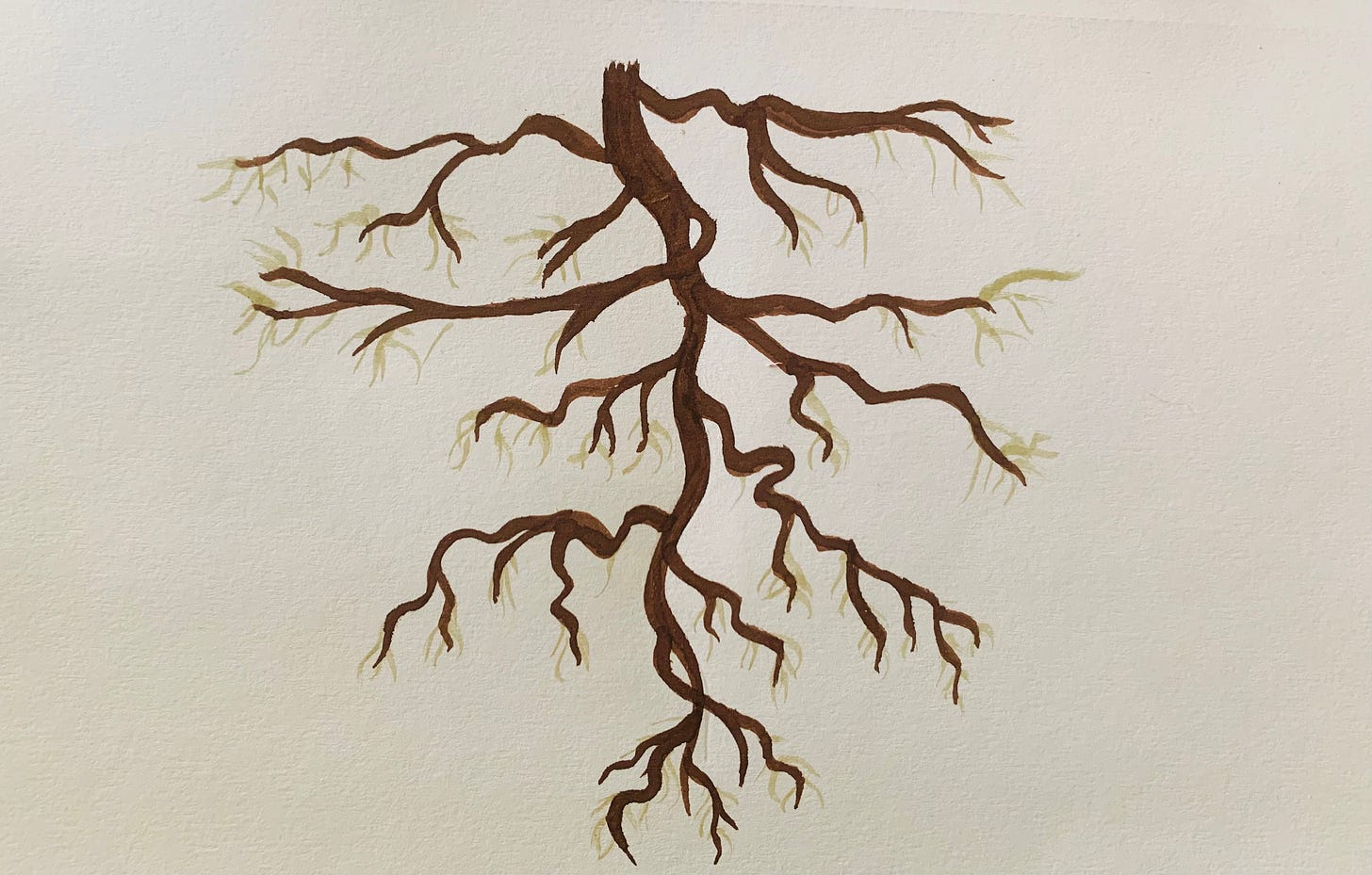Listen to the Song in the Audio ↑
Read the Story Behind It ↓
I wouldn’t go so far as to say that my thumb is green. It’s certainly not lime, and definitely not chartreuse. I’d say the color of my thumb is much closer to transitional baby poop.
That being said, I am working towards a brighter green, but it’s been a long journey. I’ve been cruzin’ around communities with gardens for over a decade, but my zucchini sizes have yet to win first place.
It’s not been exactly intuitive. Though I’d love to paint myself akin to Isabela Madrigal, blooming roses with the sway of my hips and conjuring cactuses anytime I’m pissed, my puny potatoes aren’t yet convinced. I wasn’t raised with backyard veggies, and (though I’ve gotten good theory) I often still feel like I’m crawling: patiently waiting for a cornucopia harvest only to return with a Charlie Brown basket.
It’s been humbling (to say the least) as the mistakes I’ve made in the garden so often reflect broader patterning: the fouls in my approach to growing veggies have not been so different from the fumbles of my own life journey.
For the last couple of weeks, these garden revelations came in the process of transplanting. Spring is coming with its perfect conditions for planting: warmer, longer days, and reliable showering.
So, we’ve been getting the garden ready, which has included clearing big herb bushes out of the beds and into the ground where they can stretch their legs. Also, I’ve begun planting the veggies from my very own nursery, where I’ve proudly raised my babies from seeds that I collected and dried, watered and sprouted over wintertime. Plus, in the native plant nursery (where I volunteer regularly), we’ve been focused on up-potting (which means giving baby plants more space for growing).
All in all, I’ve been learning a lot about the process of expanding into bigger places that offer more opportunities. It’s not all been a failure: 2/3 of the trees I transplanted last fall are flowering and grew taller than me. 100% of the plants I propagated and transplanted a few weeks ago are succeeding.
Still, along the way, I’ve been reminded of how tender these times of rapid growth can be. While moving into bigger spaces is essential for developing, the process can be risky; ripped roots, harsh weather and new soil can be very threatening. Life takes time to adjust while developing.
With that in mind, good practice in transplanting is to isolate the different variables of change over time so that plants can adjust to each difficulty separately.
Here’s some considerations for successful transplanting:
Firstly, (if you can) move your baby plants into bigger spaces before their roots become bound in pots that they’ve outgrown. When plants grow in a pot for too long, their roots can start circling around the bottom, which can make it harder for them to spread out once they’ve been given more room; unless you break-up the roots that are circling, they will likely continue their circular trajectory -which is problematic for roots that are meant to branch out. Furthermore, the density that’s created with roots that have been left in the pot for too long can also foster “root rot”: a fungus that thrives in the extra moisture and lack of oxygen that’s created by the roots entanglement.
Then, for plants that are being moved out of the nursery (where they’ve been protected from harsh weather and treated very carefully), it’s helpful to “harden them off before planting” which means slowly moving the plant into its new destination, giving the extra sun, shade or wind in small doses. This gradual transition allows the plant to get used to its new conditions before the (sometimes traumatic) process of being planted.
That being said, when removing a plant from the pot (or digging it out of the ground), it’s important to know how sensitive the plant’s roots are, and to treat them accordingly. Some plants have very delicate roots that get very fussy when broken or exposed to air, while some plants can take much more breaking, and require a little less care. Generally speaking, it’s important to avoid cutting or exposing the roots as much as possible.
Then, when finally planting into the ground, there’s a few important considerations:
Firstly, choose a gentle time of day and a gentle season (generally this is spring and fall and morning and evening). Avoiding harsh weather is helpful when transitioning.
Then, when digging the hole, it’s important to dig it wider than the root-ball, especially if the surrounding soil is more rocky or compacted than the soil from the pot. This is because the effort that it takes for the roots to grow through tougher soil can be overwhelming for a plant who’s already having to recover from roots that have been disturbed, and/or new weather. Surrounding the root-ball with a pad of soil that’s similar to what they’re used to gives them some time to recover before asking them to push into the new.
Finally, once the plant is in its new home, it’s important to keep it hydrated (without letting it drown). Furthermore, it’s best not to fertilize until plants become established, as too much fertilizer can burn them. Indeed, though transplants need TLC, there can certainly be too much of a good thing.
Though the list of considerations for transplanting is longer than this, overall it’s been important for me to realize that the process is delicate, that big growth requires patience and gentleness.
This has been a valuable reflection because I’ve not always been tender with my own transformation. I’ve approached my own growth (and the growth of those around me) with a harsh kind of forcing, with an expectation that myself (and others) need to grow quickly. But, this approach has been harmful, disorienting and overwhelming. Indeed, personal growth first means revealing blindspots in the way I see and changing the way I understand things (and this can be wilting). Then, it means changing my habits, lifestyle, and priorities to reflect my new way of seeing (and this can be confusing and exhausting).
Yet, for a long time I tried to force myself to grow bigger and faster than I was able to keep up with. I’d rip my tangled roots with shame and punishment in a desperate attempt to force a new direction. Then, I’d throw myself into rough weather in hopes that it would toughen me and make me do better. Then, I’d douse myself in facts and figures (like excessive fertilizer), thinking that tons of proof would make me grow faster.
But, in the end, the result was stunting, and I experienced my own kind of transplant shock: leaves that yellow and growth that stops. Indeed, when a plant is treated roughly and then exposed to too many new conditions at once, it tends to shut down, and can even die in its struggle to adjust.
My rushed and harsh approach to growth, however, did come from understandable places -and growing this understanding has been part of growing my gentleness.
Here’s a little more about the roots to my own imbalance:
Firstly, the dominant culture that I was raised in values fast and ample production. Cutting corners in the name of speed and abundance is common (and sometimes encouraged as efficient). Desperate for results, I sometimes trampled on things.
Secondly, I’ve lived a life that’s been overwhelming as I’ve tried to prove myself productive and worthy. But this resulted in overcommitment (that was often destructive). The overwhelm that ensued made me less sensitive to the delicate details of my creations.
Furthermore, I’ve been confused about when to be gentle and when to be rough. Indeed, there are times when it’s important to toughen-up. I’m certainly not gentle when I’m pulling out the taproots of weeds, and trees need the wind when their trunk is strengthening; if a tree has been staked for too long, it can become overly dependent, making their trunks more susceptible to breaking. That being said, knowing when to be tough and when to be delicate can be confusing.
Finally, in the dominant culture that I come from, sensitivity and gentleness have been generally regarded as weak and undesirable characteristics. As a result, I haven’t always trusted tenderness.
But even if I had figured it all out, I went a good 15 years with a massive energy drought: constantly exhausted from a lack of sleep, and worried that at any time my bottom could leak: IBS gas, depression and anxiety: I just wanted to get everything over quickly.
All that being said, I’ve sometimes caused my own hardships by pushing myself and others to adjust and expand too fast, and by being too rough with my roots when I’m transplanting them.
But, thankfully, I have been loved by people who have treated me tenderly. Thanks to inspiring artists, friends and family, I’ve been shown the power of being grown gently. When others have been sensitive to me, I’ve treated life more sensitively. When they’ve been patient with me, I’ve treated life more patiently. They softened me with their softness, tenderized me with their tenderness, and made me more caring with their carefulness.
So, in these delicate times of transformation, this song is dedicated to those who helped me balance toughness with tenderness, enthusiasm with patience, and to better discern when each is needed.
Thank you for nurturing my growth so carefully even after times that I’ve approached life harshly. You make it feel safe to be growing and expanding.














Share this post